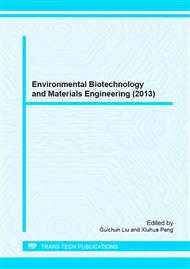p.434
p.440
p.444
p.449
p.453
p.457
p.461
p.467
p.472
Comparative Analysis of Environmental Impacts between Dregs Disposal and Conventional Cement Production by Life Cycle Assessment (LCA)
Abstract:
The environmental impacts of the dregs disposal in cement kiln and conventional production were contrastively evaluated by life cycle assessment (LCA) in this study. The results showed that the environmental load ratio of both cement productions followed the order of energy depletion potential (EDP) > depletion potential (ADP) > global warming potential (GWP) > acidification potential (AP) > human toxicity (HT) > photochemical ozone creation potential (POCP). The comprehensive environmental load of disposal dregs was 14.465×10-12/a, which was 3.98% lower than that of the conventional cement production. Moreover, the reduced percentage of the environmental load followed the order of HT> AP> POCP> EDP> ADP> GWP, which indicated that the reduced percentage of human toxicity and acidification reached 10.62% and 10.06% respectively. Thus, considering the environmental benefits, it would be a better method to dispose dregs instead of limestone in cement kiln.
Info:
Periodical:
Pages:
461-466
Citation:
Online since:
September 2013
Authors:
Keywords:
Price:
Сopyright:
© 2013 Trans Tech Publications Ltd. All Rights Reserved
Share:
Citation:


